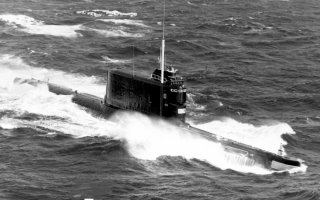Mission Impossible? How the U.S. Navy Tried to Steal a Dead Russian Submarine's Secrets
The six-year effort was arguably the single most impressive feat of naval engineering in history.
Bradley, forty-seven, was an enigma even to most people in his own branch. If you looked him up in the Pentagon’s official record, you’d see his assignment as “Naval Operations, Navy Department,” a designation about as specific as referring to a professor of chemistry as “Faculty, University.” In reality, Bradley oversaw highly compartmentalized black programs from an unmarked bunker on the fifth floor of the Pentagon, hidden behind three sets of locked doors. There, Bradley considered ways to use some of the Navy’s most sophisticated and secret tools to unlock mysteries of the Soviet arsenal, in particular its submarine, encoded communications, and ballistic missile programs.
It was obvious to Bradley and anyone else who had been told about the Soviets’ vast and fruitless search of the North Pacific that they’d lost a sub—a sub the Navy suspected with some confidence to be the K-129. This presented a tantalizing thought: If the US Navy could locate the sub’s precise location, it might be able to access the wreck and mine it for a host of valuable intelligence—including communication codes, code-breaking machinery, and most compelling of all, the nuclear warheads atop the ballistic missiles. Any combination of these things would provide the single most important intelligence haul of the Cold War to date.
Both the United States and the Soviet Union knew basically what the other side was packing, but when it came to the specifics of those atomic missiles and warheads, the two adversaries were guessing. Getting their hands on an actual Soviet missile, intact, would allow US nuclear analysts to unlock any number of secrets about the enemy’s arsenal, in particular the makeup of the warheads and the design of the guidance system, which could enable the United States to build better antimissile defenses specially calibrated to the Soviet design.
While the idea of finding a missing submarine in the Pacific Ocean, even when they had a general idea of where to search, proved so daunting to the Soviets that they’d ultimately given up looking, Bradley was fairly optimistic. He had a better way of locating it.
The story of the missing sub and its eventual recovery by American forces is one of the most fascinating chapters of the Cold War. Josh Dean’s new book, The Taking of K-129: How the CIA Used Howard Hughes to Steal a Russian Sub in the Most Daring Covert Operation in History, is available from Amazon and bookstores everywhere.
This article by Task and Purpose originally appeared at Task & Purpose. Follow Task & Purpose on Twitter. This article first appeared in 2017.
Image: Wikimedia Commons

